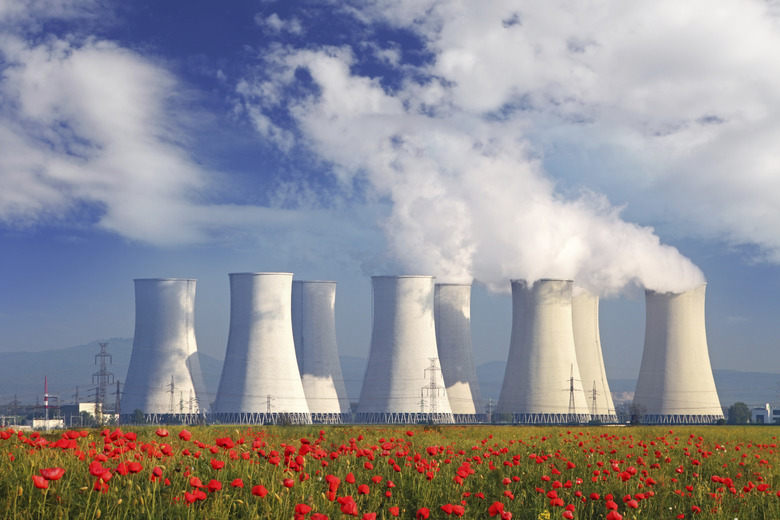How Does A Cooling Tower Work?
Fly over a large, hyperboloid cooling tower and you'll see mist clouds floating from its top. A hyperboloid is the 3-dimensional shape that forms when you revolve a hyperbola around its axis. The cooling tower's mist clouds consist of evaporated water and heat that the tower extracts from an oil refinery, steel mill, nuclear power plant or other industrial heat source. Although other types of cooling towers exist, hyperboloids are good to study when you want to learn how large-scale evaportative cooling works.
Evaporative Technology: The Science Behind Cooling
Evaporative Technology: The Science Behind Cooling
A liquid's temperature decreases during evaporation because molecules that remain in the water have lower average kinetic energy than molecules that escape and enter the vapor stage. You witness this effect when perspiration evaporates, leaving your body cooler, and when evaporative cooling units whisk away a room's heat in summer.
Evaporative Cooling Tower Fundamentals
Evaporative Cooling Tower Fundamentals
Hyperboloid cooling towers use a process similar to the one found in small evaporative cooling units. Warm water from a heat source, such as a power plant, enters a cooling tower, where pumps move the water to fill material at the tower's top. As water flows down that material, incoming air strikes the water and causes some of it to evaporate. Evaporation removes heat from the water, and the cooler water moves back though the heat source to cool it. Heat and evaporated water exit the top of the cooling tower, creating the mist cloud you see.
Content of the Mist
Content of the Mist
Water exits the top of a cooling tower in one of two forms: drift or evaporative. Drift emissions consist of water that contains suspended and dissolved solids. Evaporative emissions are pure water that could contain contaminants. Water in these towers can contain treatment additives that prevent scaling, corrosion and other problems that decrease efficiency.
Alternative Cooling Tower Uses
Alternative Cooling Tower Uses
Hydroelectric plants harness the power of moving water to generate electricity. As of September 2014, Solar Wind Energy, Inc., planned to build a massive hyperboloid energy tower that can do the same thing. Rising 685.8 meters (2,250 feet) into the air, the tower would pump sea water to the top and release it as a mist. This would cool the air, causing it to fall at a velocity high enough to spin turbines that would produce 610 megawatts of electricity. The tower's hyperboloid shape — wide at the top and thin in the middle — would help the tower produce energy more efficiently.
Other Cooling Tower Types
Other Cooling Tower Types
Scientists call hyperboloids "wet cooling towers" because they use evaporative cooling. Dry cooling towers use other methods to cool water and return it to its source. You can also find other types of cooling towers that provide heating, ventilation and air conditioning cooling for schools, office buildings, hotels and similar establishments. It's important to disinfect cooling tower water, because bacteria can breed there. Legionella, which is responsible for Legionnaires' disease, find cooling towers ideal environments in which to propagate.
References
- Snow College Cindy Alder Assistant Professor of Mathmatics: The Hyperbola
- Downstream Process Technology: A New Horizon In Biotechnology; Krishna Prasad
- Department of Ecology State of Washington: Cooling Towers
- PBS Nova Next: Proposed Hyperboloid Energy Tower Uses Simple Math to Solve a Big Problem
- Centers for Disease Control and Prevention: Cooling Towers
Cite This Article
MLA
Lee, Kevin. "How Does A Cooling Tower Work?" sciencing.com, https://www.sciencing.com/cooling-tower-work-4899957/. 24 April 2017.
APA
Lee, Kevin. (2017, April 24). How Does A Cooling Tower Work?. sciencing.com. Retrieved from https://www.sciencing.com/cooling-tower-work-4899957/
Chicago
Lee, Kevin. How Does A Cooling Tower Work? last modified March 24, 2022. https://www.sciencing.com/cooling-tower-work-4899957/
